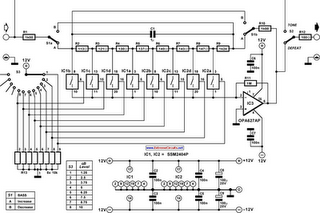Home » Circuits
Accurate Bass Tone Control
A difficult problem in the design of conventional stereo tone controls is obtaining synchronous travel of the potentiometers. Even a slight error in synchrony can cause phase and amplitude differences between the two channels. Moreover, linear potentiometers are often used in such controls, and these give rise to unequal performance by human hearing. Special potentiometers that counter these difficulties are normally hard to obtain in retail shops. A good alternative is a control based on a rotary switch and a discrete potential divider. The problem with this that for good tone control more than six steps are needed, and switches for this are also not readily available. Fortunately, electronic circuits can remove these difficulties.Circuit diagram:

The analogue selectors used may be driven by mechanical switches, standard logic circuit or a microcontroller. The selectors used in the present circuit are Type SSM2404 versions from Analogue Devices, which switch noiselessly. Each IC contains four selectors, so that a total of eight are used. The step size is 1.25 dB at 20 Hz with a maximum of 10dB . The circuit can be mirrored with S1, which means that a selection may be made of amplification or attenuation of bass frequencies. The user can choose between attenuation only and extending the range by dividing R9. The control can be bridged by switch S2.
To prevent the output impedance of the circuit having too much effect on the operation of the circuit, the output impedance must be ≤ 10 Ω. Resistor R1 2 protects the circuit against too small a load. At maximum bass amplification at Ui n = 1 V r.m.s., the THD+N <0.001% for a frequency range of 20 Hz to 20kHz and and a bandwidth of 80kHz. The circuit draws a current of about 10 mA.
